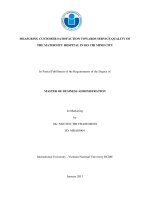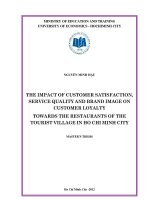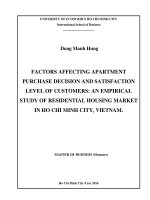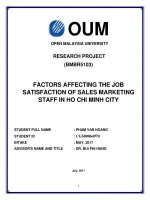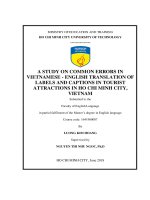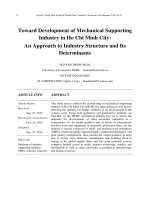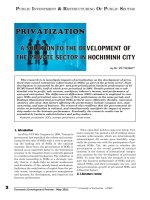The impact of customer satisfaction, service quality and brand image on customer loyalty towards the restaurants of the tourist village in ho chi minh city
Bạn đang xem bản rút gọn của tài liệu. Xem và tải ngay bản đầy đủ của tài liệu tại đây (554.8 KB, 94 trang )
MINISTRY OF EDUCATION AND TRAINING
ACKNOWLEDGEMENTS
UNIVERSITY OF ECONOMICS - HOCHIMINH CITY
I would like to express my appreciation to Dr. Tran Ha Minh Quan for his
motivation, support. This thesis would not be completed without his support,
enthusiasm. He transferred professional knowledge of research methodology to
me has improved my research skills and provided useful guidance throughout my
academic career.
I greatly appreciate to the board of managers in Van Thanh Tourist Village, Tan
NGUYỄN MINH HẬU
Cang Tourist Village who allowed me to conduct the survey at these restaurants.
I would like to thank the customers at the restaurants of the Tourist Village in Ho
ChiTHE
Minh City
for their participation
of effective data collection.
IMPACT
OF CUSTOMER
SATISFACTION,
I
SERVICE QUALITY AND BRAND IMAGE ON
greatly thanks to Mr. Nguyen Van Cuong, who spent hours with me for the
CUSTOMER LOYALTY
interview.
TOWARDS THE RESTAURANTS OF THE
IN
HO CHI
MINH
CITY
Lastly,TOURIST
I offer my regardsVILLAGE
to all of those who
supported
me during
the research.
Ho Chi Minh, Viet Nam
MASTER’S THESIS
April, 11th, 2012
Nguyen Minh Hau
1
Ho Chi Minh City -2012
MINISTRY OF EDUCATION AND TRAINING
UNIVERSITY OF ECONOMICS - HOCHIMINH CITY
NGUYỄN MINH HẬU
THE IMPACT OF CUSTOMER
SATISFACTION, SERVICE QUALITY AND
BRAND IMAGE ON CUSTOMER LOYALTY
TOWARDS THE RESTAURANTS OF THE
TOURIST VILLAGE IN HO CHI MINH CITY
MASTER’S THESIS
MASTER IN BUSINESS ADMINISTRATION
Ology Code: 60.34.05
Supervisor
PhD. TRẦN HÀ MINH QUÂN
Ho Chi Minh City -2012
2
ABSTRACT
Nowadays, together with the social economic improvement, the living standard is
increasing and having lots of restaurants operating in Ho Chi Minh City. To
satisfy the customers’ needs, restaurants try to improve their quality of service and
find out the better ways to attract more customers. But it seems to be inefficient to
keep old customers and attract new customers. Why does inefficient state happen
and last for a long time in restaurant industry? The researchers pay attention to
find the reason for the problem and discover the main factors influencing to
customer loyalty in restaurant industry.
On the other hand, one of the interesting tourist types is the Tourist Village. It
exists as the resort or the simpler type: restaurant. If resorts mainly exist in the
provinces, restaurants of the tourist village popularly exist in Ho Chi Minh city.
The restaurants of the tourist village possess some advantageous points compare
to the normal restaurants, such as: having a large square, can connect luxurious
structure of the restaurant to the use of air, atmosphere and tree building. But
even though, possessing these advantages, the number of customers come to the
restaurants of the tourist village have also decreased. Whether may It be
influenced by the common rules which have affected to restaurant industry or
having another factors aiming at the tourist village not? This is a practical
question and to supply a correct answer requires a research to show full of
theoretical side, practical side.
This thesis was conducted aiming at solving these problems and used interview. A
main survey was undertaken with a sample of 205 customers in two sites: The
restaurant of Van Thanh Tourist Village, The restaurant of Tan Cang Tourist
Village. The results reveal that customer satisfaction, the components of service
quality and the brand image of the restaurant have positive impact of customer
loyalty.
3
Based on the findings, it is recommended that the restaurants of the tourist village
in Ho Chi Minh city should consider the long term strategy as well as increasing
marketing program.
Key words:
Customer loyalty, customer satisfaction, the brand image of the restaurant.
4
TABLE OF CONTENTS
Acknowledgements ........................................................................................ I
Abstract ........................................................................................................ II
Table of contents .........................................................................................III
CHAPTER I: INTRODUCTION
1.1 Research background ..............................................................................1
1.2 Problem definition ...................................................................................3
1.3 Research questions & objectives .............................................................4
1.4 Research delimitation ..............................................................................5
1.5 Research methodology and research design ...........................................6
1.6 Significance of the research ....................................................................6
1.7 Thesis structure .......................................................................................6
CHAPTER 2: LITERATURE REVIEW & THEORETICAL MODEL
2.1 Loyalty concept ..........................................................................................8
2.2 Review of previous articles and theses on customer loyalty ..................14
2.3 Service quality concept ..........................................................................17
2.4 Customer satisfaction concept ...............................................................19
2.5 The brand image concept .......................................................................22
2.6 Impact of service quality, customer satisfaction, restaurant image on customer
loyalty ..........................................................................................................27
2.7 Factors contributing to customer loyalty ..............................................28
2.8 The conceptual framework .....................................................................29
2.9 Theoretical model and hypotheses .........................................................30
CHAPTER 3: RESEARCH METHODOLOGY
3.1 Research process....................................................................................32
3.2 Measurement .........................................................................................34
5
3.3 Preliminary survey .................................................................................37
3.4 Sampling method ....................................................................................39
3.5 Data analysis method .............................................................................39
CHAPTER 4: DATA ANALYSIS AND RESULTS
4.1 Descriptive data analysis .......................................................................40
4.2 Measure assessment ...............................................................................41
4.3 Hypotheses testing..................................................................................44
4.4 The regression model .............................................................................44
4.5 Interpretation and Discussion................................................................45
CHAPTER 5: CONCLUSION & IMPLICATIONS
5.1 Overview ................................................................................................47
5.2 Main findings .........................................................................................48
5.3 Theoretical implications ........................................................................50
5.4 Managerial implications ........................................................................51
5.5 Future research .....................................................................................53
References ....................................................................................................54
Appendix.......................................................................................................61
List of tables .................................................................................................72
6
CHAPTER I: INTRODUCTION
1.1 Research background
When Viet Nam joint WTO in 2007, Viet Nam became a central point for tourist
visiting because of its natural atmosphere and beautiful sight as well as
characteristic cuisines. To attract tourist around the world, hotel and restaurant
industries play an important role on bringing value to customers. If hotel supplies
values related to destination for tourist visiting, restaurant sends characteristic
cuisines for tourist. As a result, hotel industry has a close relationship to restaurant
industry because they aim at one objective as tourist. Take this rules, lots of resorts
had opened to supply both of hotel and restaurant services. Normally, resorts set
up at places where are near to beach and resorts focus on tourist who has the
demand on enjoying beautiful landscape and natural atmosphere. Restaurant seems
to be one of a small part of resorts to serve customer about cuisine, and hotel plays
a central point to make profit for resort because travelers tend to book room on
hotel over night during several days.
But in Ho Chi Minh City, resorts have individual characteristic where restaurant
services also play dominant role not less than hotel services. The reason is due to
the demands of customers. In table 1.1, the number of respondent who visit to Ho
Chi Minh city by attractive side is 43% and is smaller than the respondent who
visit to other province. As a place in which have many small rivers and lack of
mountain or beach, Ho Chi Minh City has not a dominant point about beautiful
sight compare to many provinces in which have beach or mountain but Ho Chi
Minh city can be thought as a place where tourist can enjoy delicious Vietnamese
food and cuisines from around the globe, including French, Indian, Mexican,
Italian, Japanese, Thai and Chinese. For this reason, tourist village in Ho Chi Minh
city had grown and can be seen as a type of resorts. In table 1.2, the number of
respondent who visit to the tourist village by attractive side is 36%. This is a small
7
percentage comparing to the respondent of who visit to star hotel and it implies
that tourist village has not attractive landscape for visitors.
In table 1.3, the structure of average expenditure out of tour for foreign visitors in
the tourist village shows that expenditure to food is 48.3% as the highest value
compared to the expenditure to food of other accommodations. This means that in
tourist village, restaurant which supplies food and beverage play an important
source of profit compared to other hotels which have restaurant component.
Although tourist village mainly focus on cuisine services which create a large
percentage of its profit but tourist can enjoy more values in here rather than
normal restaurant. Tourist village include restaurant which possesses a large
square and hotel as well as yacht service, fish hunting service. Because of its
sophisticated structure, all of its service values have an impact on customer
visiting but restaurant service play a central point to attract customer. Although,
restaurant is a part of supply chain of tourist village, but restaurant also compete
strongly with other restaurant. Especially, there are lots of restaurant in Ho Chi
Minh city which provide cuisines service not only Vietnamese characteristic but
also Asian or Europe characteristic. To survive in this competition, restaurant on
tourist village should reposition its value on two dimensions:
The first, the restaurant manager should define customer demands. Understanding
customer demands as well as analyzing factors influencing to customer loyalty is a
key to make restaurant’s success.
The second, the restaurant manger should define restaurant strength and character
in a relationship with other services of Tourist village. Defining their character is
very important and it requires define their brand image on customer perception.
There have been many studies on customer loyalty in restaurant industry to clarify
what factors influence in loyalty as well as to supply information for restaurant
manager making their solution. Previous research on customer loyalty focuses on
what main impact on loyalty in restaurant industry. Cevded Avcikurt and Murat
Dogdubay (2008) studied the determinants of customer loyalty by emphasizing on
8
the importance of food, service quality, ambiance, convenience. Rasha Alli Eliwa
(1993) focused on the image of restaurant to customer loyalty.
Beside, there has been study on customer loyalty in the tourist village of Viet Nam
country. Nguyen Thi Tuyet Loan (2011) studied the impact of service quality,
customer satisfaction on customer loyalty in the tourist village of Da Lat province.
This study had also pointed out that some factors have influence in customer
loyalty in the tourist village, including price, service quality and customer
satisfaction.
So far there has been no research on customer loyalty in restaurant of the tourist
village. To approach the tourist village, determinants of customer loyalty in
restaurant can be different from the result of previous research because of its
characteristic. It is also necessary to research on customer loyalty in restaurant on
the tourist village in Ho Chi Minh city so as to out line marketing strategies,
increase the profit of restaurant and so far create the compared advantages of the
tourist village.
1.2 Problem definition
In table 1.4, the number of tourist foreigner respondent who decide to visit
Vietnam by friends, relations in the tourist village is 18.2% and is smaller than
other accommodations. This means that the impression of visitors to the tourist
village is not high and they are not willing to introduce to their relations or friends.
It is a signal to consider about the customer loyalty forwards to the tourist village
as well as to the restaurant of the tourist village.
In table 1.5, the number of tourist foreigner respondent on best impression
forwards to the tourist village is 30.3 percent for landscape, and 30.3 percent for
cheap commodities. The percentage of respondent to landscape of the tourist
village is smaller than other accommodations so it can be considered that
landscape is not an advantage side of tourist village. On the other hand, cheap
value makes strong impression for visitor forwards to the tourist village compared
9
to other accommodations. So, beautiful side or cheap value is whether a factor
influencing to customer loyalty in the restaurant of the tourist village or not?
On the other hand, in restaurant industry, a competition always exists and directly
influences in lots of activities of restaurant. Facing to competition, the restaurant
of the tourist village in Ho Chi Minh city is not outside from this rule. In the
restaurant of Tan Cang tourist village, the restaurant managers try to reduce price
of buffet and set menu to attract customer. On the other hand, in the restaurant of
Van Thanh tourist village, the restaurant managers improve the effectiveness of
green areas policy to provide clean value for customers. But following to the
internal statistic source of Tan Cang, Van Thanh tourist village (Table 1.6), during
the time of price reducing and green areas policy taken, the total of revenue of
restaurant decreased slightly because of the amount of customer reducing. So,
what are factors which influence in customer loyalty in the restaurant of the tourist
village in Ho Chi Minh city?
Another problem is that on the tourist village, restaurant is a part and when
managers need an investment, they face financial pressure. Beside restaurant
investment, manager must figure out what items need improving and should be
invested. As a result, with the limitation of financial source, what should managers
invest to restaurant to bring the most values for customer?
Clearly, keeping customer, creating customer impression is not easy and it must be
considered carefully. This thesis is to supply basic and useful information for
restaurant manager on the tourist village finding out the best solution.
1.3 Research questions & objectives
To solve the problems which are mentioned above, this research aims at finding
out the answer for the following questions:
What are the determinants of customer loyalty in the restaurant of the tourist
village in Ho Chi Minh city? By defining the factors impacting on customer
loyalty, the restaurant manager can make full solution strategies to attract
10
customer. And when considering a systematic solution, it can eliminate the
disadvantage side of decisions on marketing.
What is the model to show the level of influences affect to customer loyalty
forward to the restaurant of the tourist village? By addressing the model of
customer loyalty, the restaurant manager can define what should invest in a line of
prior levels. It is necessary in accordance with limiting financial source. On the
other hand, through the model of customer loyalty, it can supply what model for
the connection between restaurant service and other services on the tourist village.
Based on the above research question, the study objective is to examine:
1. The impacts of customer loyalty in the restaurant of the tourist village in Ho Chi
Minh City.
2. The model of influences affecting to customer loyalty in the restaurant of the
tourist village in Ho Chi Minh City.
1.4 Research delimitation
The research was limited in some dimensions:
The research only focused on some factors affecting to customer loyalty, including
customer satisfaction, service quality and brand image. Next study can focus on
the full of image component affecting to customer loyalty. By addressing the
effect of the image to customer loyalty, restaurant manager can build an image of
the restaurant properly.
The research was narrowed to the age lower 13 years old. The research only
focused on adults who had enough knowledge and made decision to revisit or not.
Next study can widen the framework of age to address factors influencing in
young customer loyalty. In some cases, children have the power to convince their
parents choosing a suitable restaurant of the tourist village.
11
The research did not focus on the variety of customers, not to separate the result
follow to age, gender. So, the result of this result only supplies the overall picture
of customer loyalty in the restaurant of the tourist village in Ho Chi Minh City.
1.5 Research methodology and research design
The study used a survey to receive information of customers. This survey was
conducted at two sites: Tan Cang tourist village, and Van Thanh tourist village.
There were total of 230 samples sent to customers who visiting to restaurant of
these tourist village. There were total of 205 samples which were received to data
collection.
After receiving data, analysis of variance was used to identify the significant mean
on the customer loyalty.
1.6 The significance of the research
As mentioned above, the research not only supplied an overview picture of
customer loyalty in the restaurant of the tourist village, but also found out the
model of the influences affecting to customer loyalty in accordance with the
hierarchy. Through the result, managers can make a conclusion what should
consider when making a systematic strategy.
1.7 Thesis structure
Chapter 1: Introduction. This chapter is to supply a brief overview of the research
background, problems and objective. This chapter also defines the limitation, the
method and the significant value of the research.
Chapter 2: Literature review and conceptual model. The chapter comprises a deep
review of literature as well as previous research. Based on literature review,
conceptual model was built.
12
Chapter 3: Research methodology. This chapter focuses on research process,
define measurements, preliminary assessment and methods to collect samples and
to analyze data.
Chapter 4: Data analysis and results. This chapter comprises the official
assessment of measure, hypothesis testing in accordance with three restaurant of
the tourist village.
Chapter 5: Conclusion and implication. Main findings are drawn out. Next to
theoretical implication and managerial implication as well as the recommendations
for the restaurant of the tourist village in Ho Chi Minh city.
13
CHAPTER II: LITERATURE REVIEW & THEORETICAL MODEL
This chapter provides an overview of available research on customer loyalty in
restaurant industry as well as supplies the relevant theories. Based on the literature
review, the conceptual framework is built.
2.1 Loyalty concept:
2.1.1 Loyalty definition:
Loyalty is a concept which is used in marketing field so much. In general, loyalty
refer to the attachment of customer to a company’s products, services and people
(Jones and Sasser, 1995). So, loyalty plays a central role for a company to keep
customer, to make sure repurchasing activity and hence, increasing revenue, profit.
When more and more companies are established, the competitiveness is very high
and the survival, improvement of a company depends on customer loyalty.
Companies try to keep customer to eliminate the ability of customer switching to
another brand. So, Nguyen and Leblanc (2001) considered loyalty as the ability of
customer resistance to switch to another brand. Depend on the type of service or
product, loyalty is defined to clear the meaning of customer attachment: In service
field, loyalty is considered as the ability of customer returning to service provider
and in product field, loyalty refers to customer’s repurchasing activity.
In the thesis, the definition of loyalty is regarded to the attachment of customer to
a company’s products, services and people. Moreover, its concept focuses on the
following main points:
The first, loyalty not only focuses on customer’s repurchasing activity but also the
intention to recommend and maintain a positive towards the service provider
((Bloemer at al., 1999, Gremler and Brown 1999, Shoemaker and Lewis 1999). I
highly appreciate a customer’s positive attitude because it leads to behavioral
customer, not only repurchasing, revisiting products or service bust also decide to
the resistance of switching to another brand.
14
The second, because of my thesis focusing on service field, loyalty is more to
concentrate on customer’s revisiting to use service than customer’s availability of
purchasing to products. It shows the effectiveness of a restaurant not only tries to
sell foods and relevant services but also to attach customer for long time.
According to Dick and Basu (1994) and Stank et al., (1999), loyalty is a long term
commitment to keep favorable attitude and to repurchase over time.
The third, customer loyalty is long term commitment to repurchase products,
services over time. This side reflects to the main character of customer loyalty. It
requires that service provider must always focus on customer loyalty and on the
returning, possessing customer loyalty also is to possess the value of customer for
long time. When customers are loyal, they are trust to the services and they are
ready to repurchase even though having other brands attracting to them.
2.1.2 Loyalty dimensions:
Because the definition of loyalty not only regards to the customer’s repurchase but
also focus on the positive attitude to service, products for a long time, so the
specialists considered loyalty including behavioral and attitudinal dimensions.
According to Kandampully and Suhartanto (2004), loyalty is a concept which
covers the behavioral and attitudinal dimensions. These dimensions focus on how
customers respond to products, services as well as the attitude to recommend,
introduce products, services to others. Researchers found that these dimensions
show the importance of customer loyalty to restaurant’s profit. The customer’s
behavior on repeat dining for a specific restaurant is the behavioral dimension
(Bowen & Shoemaker, 1998). Attitudinal dimension refers to a customer’s
intention on a a specific restaurant and recommend (Getty & Thompson, 1994).
Attitudinal and behavioral dimensions are logically integrated and attitudinal
loyalty plays an important role of good indicators to aim at existing of behavioral
loyalty. This approach implies that restaurants should measure the customers’
15
loyalty by attitudinal indicators to make sure that customers are welcome to
revisit.
In the cover of the thesis, this concept is emphasized as attitudinal dimension of
loyalty concept and to measure customer loyalty. Based on the measurement of
customer intention, attitudinal dimension show a positive correlation to behavioral
dimension and to overall customer loyalty. When customers are pleasure of
restaurant’s services, they are loyal and they will revisit to a specific restaurant if
they have possible. Moreover, when approaching attitudinal dimension, the loyalty
being considered as a long term commitment is clearly illustrated. Because of
having a positive attitude to restaurant’s services, customers have the resistance of
switching another brand and when customer’s satisfaction towards specific
restaurant is increasing enough full, customers’ commitment is established. In this
side, loyalty intension is positive correlation to customer satisfaction (Gremler and
Gwinner, 2000).
2.1.3 Loyalty prerequisites
As I mentioned above, customer satisfaction is a very important factor to loyalty
intention, so customer satisfaction is one of prerequisites of loyalty. Beside,
service quality also influence to customer loyalty. According to Gremler and
Brown (1997); Cronin and Taylor (1992), customer satisfaction and service
quality are prerequisites of loyalty. While customer satisfaction influences
customer intention, service quality has an effect on customer satisfaction and
directly influences customer loyalty (Lee, 1998). According to Danaher and
Mattsson (1998), high customer satisfaction and service quality result in higher
customer loyalty.
Besides, having many factors influence to customer loyalty, such as: customer
emotions, personal relationship or the image of a company. According to Magnini
and Honeycutt (2005), customer emotions drive customer satisfaction, loyalty and
they discussed face recognition and name recall being important to customers and
16
its effect on customer loyalty. Gutek et al. (1999) also indicated that customer
having a personal relationship with a specific employee whom shows higher levels
of service usage. By the way of keeping personal relationship to customers,
service provider gets their satisfaction and loyalty. In restaurant industry, the
image of a restaurant is very important to customer loyalty. According to Downs
and Haynes (1984), image of restaurant is related to customer loyalty. A good
image can create good feeling of customer about the overview of service quality
and set up customer satisfaction, loyalty.
Although having lots of factors influencing to customer loyalty, the main way to
retain customers is to improve customer service quality and satisfaction (Berry &
Parasuraman, 1991 ; Zeithaml & Bitner, 1996).
2.1.4 The effect of customer loyalty:
According to Markey and Hopton (200, p.135) showed that customer loyalty was
very important to the success of a company on three dimensions:
The first, revenue and market share grow by building repeat sales and referrals.
When customers are swept, they continue to buy products and use services, and
the more, increasing customer loyalty, the more, controlling repeat sales. On this
dimensions, customer loyalty is very significant because it plays a key for
company to survive.
The second, cost will be reduced because the expense of getting new customer
often is higher than the expense of keeping old customer. So, company increase
customer loyalty is also reducing the total of cost by even though not focusing on
expense of new customer, but also having the high revenue and profit.
The third, employee retention improves because of the link to customer
satisfaction increasing and service quality increasing. Researchers had found the
link between customer loyalty, customer satisfaction and service quality. As a
result, customer loyalty improves as the consequence of better service quality. The
17
way to improve service quality is also to be considered as increasing employee
retention.
2.1.5 Loyalty in restaurant industry:
In restaurant industry, customers loyalty is very important because of the
competitiveness is very high and the ability of loosing customer is a common
threat to most of restaurants. Many researchers pointed out that loyalty is a very
important key for restaurant managers to improve the total of revenue and profit.
Customer loyalty is an indicator for restaurant manager to control customer revisit
and win the competitors by keeping stable revenue from customer loyalty and
attracting to new customers. Having customer loyalty is also a good signal for
restaurants manager to make sure the quality of service. Specialist had indicated
lots of factors to customer loyalty towards specific restaurant:
The first, food is very important to determine customer loyalty (Clark and Wood,
1998). When customers arrive to restaurant, mostly, their first demand is the
quality and range or type of food. When food is delicious, it effects to customer
notice, pleasure. To supply this demand, most of restaurants have food and
beverage manger and carry out food improvement strategy. Nowadays, if
restaurants possess a variety of type and delicious food, they seem to be dominant
compared to another.
The second, front line employee is also attractive and retain customer (Chebat and
Slusarczyk, 2005). Front line employees more often meet customer firstly and
transfer the character of restaurant to customers. Obviously, front line employees
have strongly positive influence to customer if they are trained to deal with
customers complaints and be aware of customer’s emotion. Moreover, front line
employees easily create personal relationship to customer and on this method,
customer intention to revisit to restaurant if they like and need front line
employee’s service.
18
The third, according to Kandampully and Suhartanto (2000), a restaurant image is
an important variable that influences guest’s visiting decisions. Because restaurant
is not only a place for enjoying delicious food but also a place for guests making
their relationship, showing their style, so restaurant image can create points to
their preferences. If restaurant image shows the major of customer preferences,
customers will be please and ready to revisit and otherwise, they don’t like and
choose another restaurant. Perceiving of restaurant image strongly impacting on
customer preferences, many restaurant try to build their specific image and
character to attractive groups of customers whom are suitable.
Besides, specialists also indicate other factors influencing to customer loyalty in
restaurant, such as: cost/value, the place, etc by the way of forming customer’s
experience and determine whether they revisit or not.
In conclusion, although having lots of factors to customer loyalty, but they can be
summarized into many main groups: The service quality and the image of
restaurant. The service quality group including quality of food, quality of front
employee’s service, cost and value and the place of restaurant can be influence to
customer satisfaction, customer loyalty. The image of restaurant, including the
atmosphere, the structure, the brand name, the decorating can be proper to
customer’s preferences and influence to customer loyalty.
2.1.6 Measurement of loyalty:
According to Bowen and Chen (2001), loyalty can be measured by three
distinctive approaches: 1- Behavioral measurements, 2- Attitudinal measurements,
3- Composite measurements.
Behavioral measurements refer to a customer’s repurchase (Bowen and
Shoemaker, 1998). Based on the amount of purchasing time or revisit time,
researcher can determine the degree of customer loyalty. This measurement is
suitable to the product field, when can easily count the number of time which
customer buys products.
19
Attitudinal measurements refer to emotional and psychological attachment
(Baloglu 2002). Based on the positive or negative attitude, researchers can
determine the overall of customer loyalty. This measurement is proper to the
service field, when emotional, attitudinal side play an important role to customer
loyalty.
Composite measurements are the combination of behavioral and attitudinal
dimensions. According to Bowen and Chen (2001), in this measurement, loyalty is
determined by preferences, frequency of purchase or visit and propensity of brand
switching.
2.2 Review of previous articles and theses on customer loyalty
2.2.1 Review of previous articles on customer loyalty:
According to Fassnact and Daus (2004, p.5-7), factors which impact on customer
loyalty are classified into three groups:
The first, company related determinants focus on the factors refer to the supplier
itself or the goods, services. It means that based on restaurant reputation or its
product quality, its service quality, customers choose to attach to company. In this
group, reputation or brand image of the restaurant is very important because it
provides the symbol for customer loyalty.
The second, relationship related determinants focus on the factors refer to the
relationship between customer and supplier. By the way to provide service or
product, this relationship is built and to influence in customer loyalty. Based on
their experiences, their trust and commitment, customers choose restaurant to
attach for long time.
The third, customer related determinants focus on the factors refer to customer
characteristics. Customers tend to choose restaurant which is proper to their
condition living and their preferences. It also analyses why with the same
restaurant and its service, but one group of customers like and to be loyal but
20
another group does not like and not to be loyal. In this group, affect and
involvement are the determinants of customer loyalty.
Fassnacht and Daus (2004, p.8-9) also grouped the determinants of customer
loyalty in empirical researches: Product and service quality; Product line
availability accessibility; Image and Reputation; Customer loyalty program;
Intensity
and
quality
of
business
relationship;
Own
experiences
and
recommendations from others; Trust; Commitment; Economic switching barriers;
Psychological and social barrier to switching; Socio-demographic customer
attributes; Affect; Involvement; Importance of the product for the customer;
Pattern of customer’s behavior; Expectations; Utility from consumption / Business
relationship; Attractiveness competitor offers / Incentives to change; Proactive
improvement. As a result, product and service quality; image and reputation; trust;
commitment; proactive improvement are the determinants which had been
concentrated to reveal. It implies the important impacts of service quality, product
quality, image and reputation as well as trust, commitment, proactive
improvement on customer loyalty.
2.2.2 Review of previous theses on customer loyalty in restaurant industry:
There are many articles and theses researching the impact on customer loyalty in
restaurant industry.
On the thesis of customer loyalty in the specialty restaurants: An example from
Istanbul by Cevded Avcikurt and Murat Dogdubay (2008), they presented the
model of five independent variables affecting to customer loyalty, including food
quality, service quality, ambiance, convenience and the overall (satisfaction from
all things together)
The result of the research was food quality, service quality, ambiance,
convenience and the overall (satisfaction from all things together) positive
influencing to customer loyalty. Although, this research defined food quality as a
21
part different from service quality but the conclusion also focus on service quality,
satisfaction as the key factors to customer loyalty.
On the study of customer loyalty and the image of the Fine dining restaurant by
Rasha Alli Eliwa (1993) presented the model of two independent variables
affecting to customer loyalty, including customer satisfaction and the image of the
restaurant..
The result of the research was customer satisfaction and the image of the
restaurant positive impacting on customer loyalty. This result implied that the
image of restaurant as a key factor to drive customer loyalty in restaurant industry.
On the study of factors influencing customer loyalty towards fast food restaurants
in Malaysia by Hossein Nezakati, Yen Leee Kuan and Omid Asgari (2011), they
stated nine factors influencing customer loyalty: product quality, product attribute,
brand name, store environment, service quality, promotion, price, trust and
satisfaction. Those factors could be grouped into four main groups: Service quality
including product quality, product attribute, service quality, promotion, price; the
image of restaurant including store environment, brand name; the customer trust
and the customer satisfaction.
On the research of factors influencing customer loyalty towards fast food
restaurants by Hossein Nezaki, Yen Lee Kuan and Omid Asgari (2011), the model
of customer loyalty were:
Customer loyalty = constant value + 0.586 * product quality + 0.285 * promotion
+ 0.219 * brand name + 0.407 * product attribute + 0.326 * store environment +
0.3 * service quality + 0.361 * price + 0.455 * brand trust + 0.385 * customer
satisfaction. This research implied that in the fast food restaurant, lots of factors
affect to customer loyalty and the brand, customer satisfaction, product quality,
service quality as the main factors.
22
Based on previous articles and theses, there are three main groups of factor
influencing to customer loyalty: Customer satisfaction, service and product
quality, brand and image of the restaurant. Although, these factors are researched
and discussed too much, but when approaching customer loyalty in the restaurant
of the tourist village is a new article, so it is necessary to review the influence of
these factors to customer loyalty.
2.3 Service quality concept:
2.3.1 Service quality definition:
Service is a concept which is used to differentiate with product. Compared with
product, service is considered as intangible, heterogeneous, unable to be kept in
stock, etc. Gronroos (1990) defined service as follow: “A service is a process
consisting of a series of more or less intangible activities that normally, but not
necessarily always, take place in interactions between the customer and service
employees and/or physical resources or goods and/or systems of the service
provider, which are provided as solutions to customer problems”. This concept
implies that service is a type of the relationship between provider and customer
which including lots of activities on several dimensions from resources, goods,
systems to solutions.
Based on the above concept, service quality can be thought as the quality of
service activities. In this view, service quality is different from product quality
based on the difference between service and product. However, many researchers
had different approach to service quality concept. When customers buy product,
they have their judgment about a product overall quality. According to Zaithaml
(1998), service quality as the customer judgment about the overall excellence of
product. This concept implies that service quality being related to overall sides:
employee’s performance, feature, product quality, conformance, etc to reflect how
customers perceive service value. So, service quality and customer satisfaction are
23
closely related (Lee, 1998). Service quality has an impact on customer perception
as well as influence in customer purchasing choices (Bruck et al, 2000).
In this thesis, service quality can be understood more widely than product quality.
If product quality aim at the quality of product, to supply information about
whether product is good or not, service quality exposes more features impacting
on customer. According to Gravin (1987), service quality includes the eight
dimensions:
performance,
feature,
reliability,
conformance,
durability,
serviceability, aesthetics, and perceived quality. Moreover, Gravin also suggested
that controlling few dimensions will result in managing customer perception of
quality which will lead to higher customer satisfaction. On the other hand, Brady
and Cronin (2001) indicated different dimensions of service quality, including
organizational, technical and functional quality, the service product, the service
delivery, the service environment, the responsiveness, the empathy, the assurances
and the tangibles related with the service experience. This approach helped to
insight in service quality by focusing on main factors which strongly influence to
customer perception. In general, although many researchers had pointed different
dimensions but they also agreed that service quality is a concept of overall quality
and being related to customer satisfaction.
2.3.2 Service quality in restaurant industry:
In the restaurant industry, service quality is also considered as overall quality
which restaurant brings values to customers, including food, employee’ service,
price, the image of restaurant, the environment, atmosphere, etc. Moreover,
service quality is very important because restaurant industry is a type of service
industry and so, all activities of restaurant will result in customer perception very
much. Although, food quality is considered to be an important part of the product
quality (Siguaw & Enz, 1999) and being a significant determinant of dining
satisfaction (Yuksel, 2002) but when the customer’ living standard improve
quickly, more and more customers pay attention to the image of restaurant which
24
satisfy the value of customer. Customer intend to choose proper restaurant
including overall service quality insteal of choosing restaurant with delicious food.
So, Henson and Trail (1993) pointed out food quality into four attributes as: food
safety, nutrition, value and package.
According to Soriano (2002), service quality in the restaurant industry is
summarized into four dimensions as follows:
1. Quality of food: menu variety, innovative food, presentation of food, fresh
ingredients and food consistency.
2. Quality of service: equipment, appearance of employees, courtesy of
employees, waiting time before being seated, waiting time before food arriving,
and waiting time before paying the bill.
3. Cost/ Value: competitively priced food and wine.
4. Place: appearance, ambience of atmosphere of a restaurant, bathroom, telephone
service parking
In this thesis, I focus service quality based on the content which Soriano reffered
to four dimensions.
2.3.3 Measurement of service quality:
Based on Soriano view, the measurement of service quality is: quality of food,
quality of service, cost/value and place.
2.4 Customer satisfaction concept:
2.4.1 Customer satisfaction concept:
In the competitive business, lots of companies take note to marketing activities
with the outcome as customer satisfaction. Fornell (1992) defined satisfaction as
an overall evaluation dependent on the total purchase and consumption experience
of the target product or service performance compared with repurchase
25

